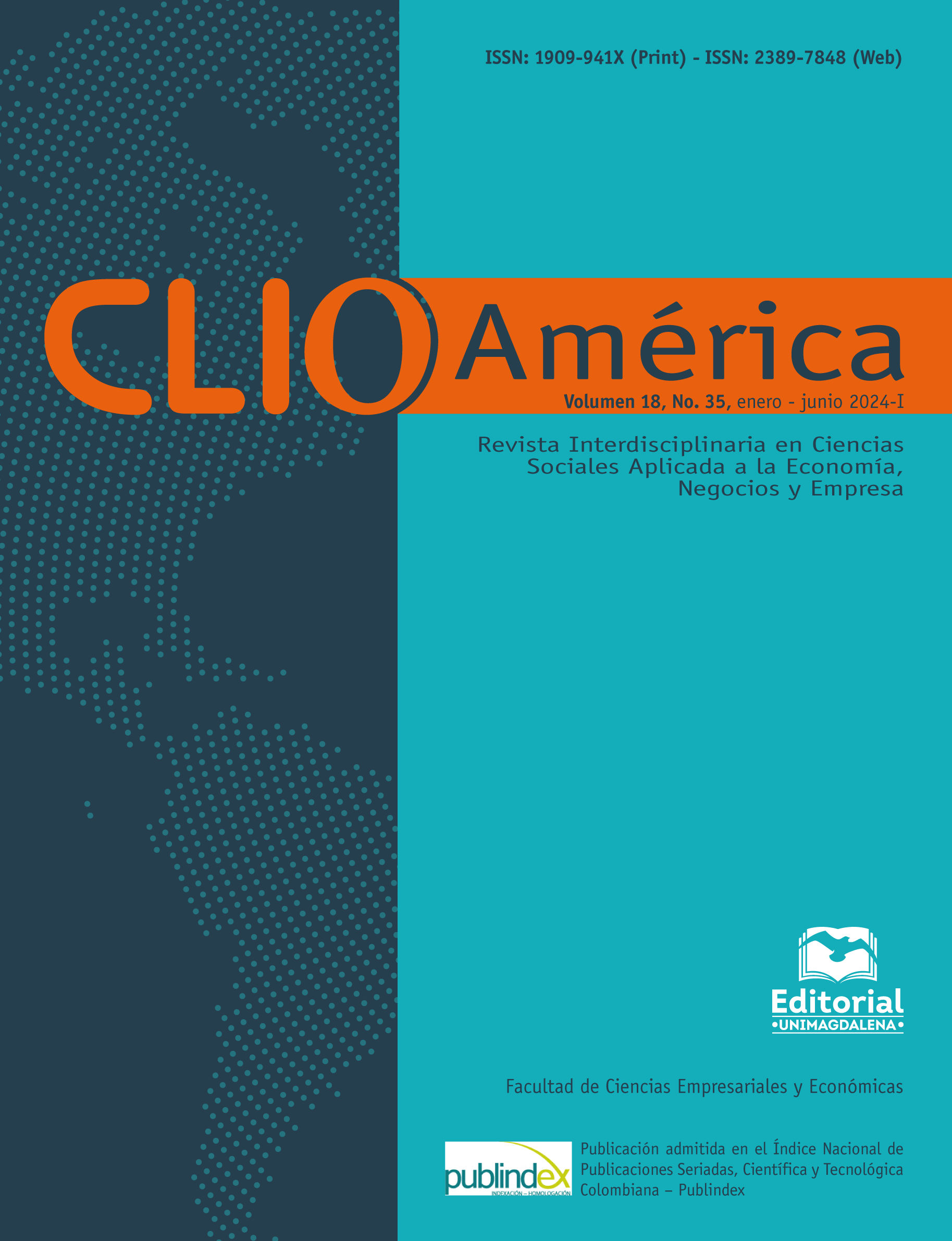Theoretical-conceptual approach to inclusive marketing: a perspective from sensory disabilities
Contenido principal del artículo
Resumen
Descargas
Detalles del artículo

Esta obra está bajo una licencia internacional Creative Commons Atribución-NoComercial-CompartirIgual 4.0.
Esta revista proporciona un acceso abierto a su contenido, basado en el principio de ofrecer al público un acceso libre a las investigaciones ayuda a un mayor intercambio global del conocimiento. De igual forma su versión impresa es de libre acceso y no tiene costos asociados por publicación.
Citas
American Marketing Association - AMA. (2017). What is Marketing? — The Definition of Marketing — AMA. https://www.ama.org/the-definition-of-marketing-what-is-marketing/
Anderson, L., Ostrom, A. L., Corus, C., Fisk, R. P., Gallan, A. S., Giraldo, M., Mende, M., Mulder, M., Rayburn, S. W., Rosenbaum, M. S., Shirahada, K. & Williams, J. D. (2013). Transformative service research: An agenda for the future. Journal of Business Research, 66(8), 1203–1210. https://doi.org/10.1016/J.JBUSRES.2012.08.013
Anker, T. B., Gordon, R. & Zainuddin, N. (2022). Consumer-dominant social marketing: a definition and explication. European Journal of Marketing, 56(1), 159–183. https://doi.org/10.1108/EJM-08-2020-0618
Arias, F. (2012). El Proyecto de Investigación (6th ed.). Editorial Episteme.
Asociación de Programas de Mercadeo. – ASPROMER. (2022). https://aspromer.com/nosotros/
Azmat, F., Ferdous, A. S. & Couchman, P. (2015). Understanding the Dynamics between Social Entrepreneurship and Inclusive Growth in Subsistence Marketplaces. Https://Doi.Org/10.1509/Jppm.14.150, 34(2), 252–271. https://doi.org/10.1509/JPPM.14.150
Azmat, F., Fujimoto, Y. & Rentschler, R. (2014). Exploring cultural inclusion: Perspectives from a community arts organisation. Http://Dx.Doi.Org/10.1177/0312896214525180, 40(2), 375–396. https://doi.org/10.1177/0312896214525180
Campbell, J. E. (2005). Outing PlanetOut: surveillance, gay marketing and internet affinity portals. Http://Dx.Doi.Org/10.1177/1461444805056011, 7(5), 663–683. https://doi.org/10.1177/1461444805056011
Casado, L. & Arrese, Á. (2022) The Era of Authentically Inclusive Marketing. Nuevas Tendencias, 7(108), 24–29. https://doi.org/10.2/JQUERY.MIN.JS
Duque-Hurtado, P., Samboni-Rodriguez, V., Castro-Garcia, M., Montoya-Restrepo, L. A. & Montoya-Restrepo, I. A. (2020). Neuromarketing: seu estado atual e perspectivas de pesquisa. Estudios Gerenciales, 36(157), 525-539.
Elizalde, M. (2021, July 5). Marketing Social e inclusivo | Revista NEO. https://www.revistaneo.com/index.php/articles/2021/07/05/marketing-social-e-inclusivo
Escuela Superior de Administración y Dirección de Empresas – ESADE. (2015). El Mercado Potencial de las Personas con Discapacidad en España. Grupo Editorial Cinca, S.A.
French, J. (2011). Why nudging is not enough. Journal of Social Marketing, 1(2), 154–162. https://doi.org/10.1108/20426761111141896/FULL/XML
George, G., Mcgahan, A. M. & Prabhu, J. (2012). Innovation for Inclusive Growth: Towards a Theoretical Framework and a Research Agenda. Journal of Management Studies, 49(4), 661–683. https://doi.org/10.1111/J.1467-6486.2012.01048.X
Gong, Z. H. (2020). Crafting Mixed Sexual Advertisements for Mainstream Media: Examining the Impact of Homosexual and Heterosexual Imagery Inclusion on Advertising Effectiveness. Journal of Homosexuality, 67(7), 916–939. https://doi.org/10.1080/00918369.2018.1564005
Gurrieri, L. & Finn, F. (2023). Gender transformative advertising pedagogy: promoting gender justice through marketing education. Journal of Marketing Management, 39(1–2), 108–133. https://doi.org/10.1080/0267257X.2022.2157461
Gurrieri, L., Gordon, R., Barraket, J., Joyce, A. & Green, C. (2018). Social marketing and social movements: creating inclusive social change coalitions. Journal of Social Marketing, 8(4), 354–377. https://doi.org/10.1108/JSOCM-12-2016-0078
Hasan, M. M., Yajuan, L. & Khan, S. (2020). Promoting China’s Inclusive Finance Through Digital Financial Services. Https://Doi.Org/10.1177/0972150919895348, 23(4), 984–1006. https://doi.org/10.1177/0972150919895348
Hasan, M., Noor, T., Gao, J., Usman, M. & Abedin, M. Z. (2023). Rural Consumers’ Financial Literacy and Access to FinTech Services. Journal of the Knowledge Economy, 14(2), 780–804. https://doi.org/10.1007/S13132-022-00936-9
Hernández-Sampieri, R. & Mendoza, C. (2018). Metodología de la investigación: Las rutas cuantitativa, cualitativa y mixta. McGraw Hill.
Ireland, J. (2008). Lessons for successful BOP marketing from Caracas’ slums. Journal of Consumer Marketing, 25(7), 430–438. https://doi.org/10.1108/07363760810915644
Kotler, P. & Armstrong. (2013a). Fundamentos de marketing. In Fundamentos de marketing (p. 5). Pearson Education, Inc.
Kotler, P. & Armstrong, G. (2013b). Fundamentos de Marketing (11th ed.). Pearson Education.
Kotler, P. Kartajaya, H., & Setiawan, I. (2010). Marketing 3.0.
Kotler, P. & Roberto, E. (1991). Marketing social: Estrategias para cambiar la conducta pública. Díaz de Santos.
Kotler, Philip. & Roberto, Ned. (1992). Marketing social : estrategias para cambiar la conducta pública. https://books.google.com/books/about/Marketing_social.html?hl=es&id=vMRDpBfowEMC
Licsandru, T. C. & Cui, C. C. (2018). Subjective social inclusion: A conceptual critique for socially inclusive marketing. Journal of Business Research, 82, 330–339. https://doi.org/10.1016/j.jbusres.2017.08.036
Mejía-Bohórquez, E., Fernando Jaramillo López, J., Restrepo Aristizábal, S., Gutiérrez Posada, V., Mauricio Maya Cadavid, L. & Pontificia Bolivariana, U. (2014). Diseño inclusivo: Comunicación para personas con discapacidad visual aplicada al punto de venta * Inclusive design: Communication for people with visual disabilities apply to the point of purchase. Revista Publicuidad |, 3, 102–141. https://doi.org/10.18566/publicuidad.v03n01.a06
Prahalad, C. K., Di Benedetto, A. & Nakata, C. (2012). Bottom of the Pyramid as a Source of Breakthrough Innovations. Journal of Product Innovation Management, 29(1), 6–12. https://doi.org/10.1111/J.1540-5885.2011.00874.X
Prahalad, C. K. & Ramaswamy, V. (2004). Co-creation experiences: The next practice in value creation. Journal of Interactive Marketing, 18(3), 5–14. https://doi.org/10.1002/DIR.20015
Robledo, S., Grisales Aguirre, A. M., Hughes, M. & Eggers, F. (2023). “Hasta la vista, baby”–will machine learning terminate human literature reviews in entrepreneurship?. Journal of Small Business Management, 61(3), 1314-1343.
Robledo, S., Osorio, G. & Lopez, C. (2014). Networking en pequeña empresa: una revisión bibliográfica utilizando la teoria de grafos. Revista vínculos, 11(2), 6-16.
Spotswood, F., Tapp, A., French, J. & Stead, M. (2012). Some reasonable but uncomfortable questions about social marketing. Journal of Social Marketing, 2(3), 163–175. https://doi.org/10.1108/20426761211265168/FULL/XML
Stanton, W., Etzel, M. & Walker, B. (2007). Fundamentos de Marketing (14th ed.). McGraw-Hill Interamericana.
Tidd, J. & Bessant, J. (2015). Innovation and Entrepreneurship, Chapter 1 - The Innovation Imperative. Innovation and Entrepreneurship, 3–44. https://www.researchgate.net/publication/285734411_Innovation_and_Entrepreneurship
United Nations. – UNESCO (2008). Convention on the Rights of Persons and Facultative Protocol https://www.un.org/disabilities/documents/convention/convoptprot-s.pdf
United Nations. – UNESCO (2022). People with Disabilities. Retrieved from https://www.un.org/development/desa/disabilities-es/algunos-datos-sobre-las-personas-con-discapacidad.html#:~:text=Alrededor%20del%2010%25%20de%20la,de%20la%20Salud%20(OMS).
Vargo, S. & Lusch, R. (2004). Evolving to a New Dominant Logic for Marketing. Journal of Marketing, 68, 1–17.
World Health Organization – WHO (2021) Disability. https://www.who.int/es/news-room/fact-sheets/detail/disability-and-health
World Intellectual Property Organization, Dutta, S., Lanvin, B., Rivera León, L. & Wunsch-Vincent, S. (2022). Global Innovation Index 2022, 15th Edition. Global Innovation Index 2022 : What Is the Future of Innovation-Driven Growth?, 42–55. https://doi.org/10.34667/TIND.46596
Zuluaga, M., Robledo, S., Zuluaga, G. A. O., Yathe, L., Gonzalez, D. & Taborda, G. (2016). Metabolómica y Pesticidas: Revisión sistemática de literatura usando teoría de grafos para el análisis de referencias. Nova, 14(25), 121-138.

